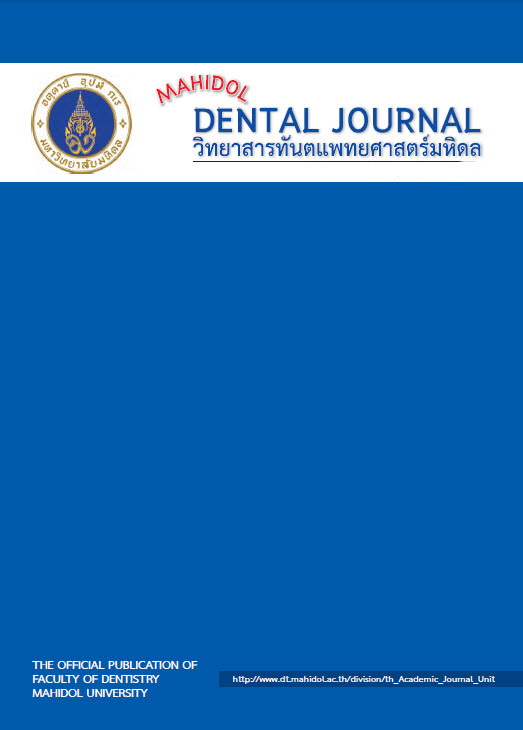Fluoride release from different powder liquid ratios of Fuji VII
Main Article Content
Abstract
Objective: The quantity of fluoride ions released from glass-ionomer cements is of major importance in the prevention of dental caries in children. Fuji VII is a glass-ionomer that releases more fluoride ions than other fluoride releasing materials.
Purposep: To evaluate the concentration of fluoride ions released from the Fuji VII with differing powder liquid (P/L) mixing ratios.
Methods: Eight cylindrical specimens from four groups with different P/L ratios were prepared and immersed independently in 10 mL of deionized water. The fluoride release was evaluated on days 1-7 using a fluoride ion specific electrode. Statistical analyses of the difference between fluoride concentrations were analyzed using one-way ANOVA and Tukey’s multiple comparison test.
Results : The fluoride released by the glass ionomers (GIs) was found to be highest during the first 24 h and decreased significantly; lower levels were obtained on day 7. Fuji VII P/L ratio 4:4 and Fuji VII P/L ratio 3:4 showed similar patterns and quantity of fluoride release, which were significantly lower than Fuji VII P/L ratio 2:4 and Fuji VII P/L ratio 1:4.
Conclusions: Fuji VII P/L ratio 2:4 and Fuji VII P/L ratio 1:4 released more fluoride than Fuji VII P/L ratio 4:4 and Fuji VII P/L ratio 3:4.
Article Details
References
2. ten Cate JM, Featherstone JD. Mechanistic aspects of the interactions between fluoride and dental enamel. Crit Rev Oral Biol Med. 1991;2(3):283-96.
3. Petersen PE, Baez RJ, Lennon MA. Community-oriented administration of fluoride for the prevention of dental caries: a summary of the current situation in Asia. Adv Dent Res. 2012;24(1):5-10.
4. Cummins D. Dental caries: a disease which remains a public health concern in the 21st century the exploration of a breakthrough technology for caries prevention. J Clin Dent. 2013;24 Spec no A:A1-14.
5. Kidd E, Fejerskov O. Changing concepts in cariology: forty years on. Dent Update. 2013;40(4):277-8,280-2, 285-6.
6. Vermeersch G, Leloup G, Vreven J. Fluoride release from glass–ionomer cements, compomers and resin composites. J Oral Rehabil. 2001 Jan;28(1):26-32.
7. Nigam AG, Jaiswal JN, Murthy RC, Pandey RK. Estimation of Fluoride Release from Various Dental Materials in Different Media—An In Vitro Study. Int J Clin Pediatr Dent. 2009 Jan;2(1):1-8.
8. Bayrak S, Tunc ES, Aksoy A, Ertas E, Guvenc D, Ozer S. Fluoride Release and Recharge from Different Materials Used as Fissure Sealants. Eur J Dent. 2010 Jul;4(3):245–50.
9. Wilson AD, Kent BE. A new translucent cement for dentistry. The glass ionomer cement. Br Dent J 1972;132:133-5.
10. Croll TP, Nicholson JW. Glass ionomer cements in pediatric dentistry: review of the literature. Pediatr Dent. 2002 Sep-Oct;24(5):423-9.
11. Mousavinasab SM, Meyers I.: Fluoride Release by glass ionomer cements, Compomer and Giomer. Dent Res J (Isfahan). 2009;6(2):75-81
12. Crisp S, Lewis BG, Wilson AD. Characterization of glass-ionomer cements: 2. Effect of the powder: liquid ratio on the physical properties. J Dent 1976;4:287-90.
13. Wiegand A, Buchalla W , Attin T. Review on fluoride – releasing restoration materials- Fluoride release and uptake characteristics, antibacterial activity and influence on caries formation. Dent Mater 2007;23:343-62.
14. Torabzadeh H, Ghassemi A, Janani A, Raoofinejad F, Naderi H. Effect of Powder/Liquid Ratio on Fluoride Release of Glass Ionomers. Beheshti Univ Dent J 2015;32(4):279-86.
15. Markovic DLj, Petrovic BB, Peric TO. Fluoride content and recharge ability of five glass ionomer dental materials. BMC Oral Health. 2008 Jul 28;8:21
16.Tay WM, Braden M. Fluoride ion diffusion from polyalkenoate (glass–ionomer) cements. Biomaterials. 1988 Sep;9(5):454-6.
17. Amaral MT, Guedes-Pinto AC, Chevitarese O. Effects of a glass-ionomer cement on the remineralization of occlusal caries--an in situ study. Braz Oral Res. 2006 Apr-Jun;20(2):91-6.
18. Muzynski BL, Greener E, Jameson L, Malone WF. Fluoride release from glass ionomers used as luting agents. J Prosthet Dent. 1988 Jul;60(1):41-4.
19. Perrin C, Persin M, Sarrazin J. A comparison of fluoride release from four glass-ionomer cements. Quintessence Int. 1994 Sep;25(9):603-8.
20. Forsten L. Resin-modified glass ionomer cements: fluoride release and uptake. Acta Odontol Scand. 1995 Aug;53(4):222-5.
21. Lohbauer U. Dental glass ionomer cements as permanent filling material —properties, limitations and future trends. Materials 2010;3(1):76-96.


